Operations Management Report: Hospital Wastage and Boeing Case Studies
VerifiedAdded on 2023/01/18
|14
|4431
|48
Report
AI Summary
This report is a comprehensive analysis of operations management, structured into three parts. Part A examines hospital wastage, applying the Toyota Production System (TPS) to improve efficiency and patient satisfaction. It identifies various types of waste, such as time and inventory, and explores how Toyota's lean principles can address these issues. Part B shifts focus to The Boeing Company, analyzing its location and layout strategies, inventory management, and approaches to overcome manufacturing delays and reduce cycle times. Part C contrasts Ford's assembly line with modern customization in operations management, assessing their suitability. The report highlights the similarities between healthcare and manufacturing, emphasizing the importance of customer-centric approaches and continuous improvement in achieving optimal operational performance. It also covers the impact of lean methodology on performance, emphasizing continuous improvement and employee engagement. The report aims to provide insights into optimizing operations across different industries.
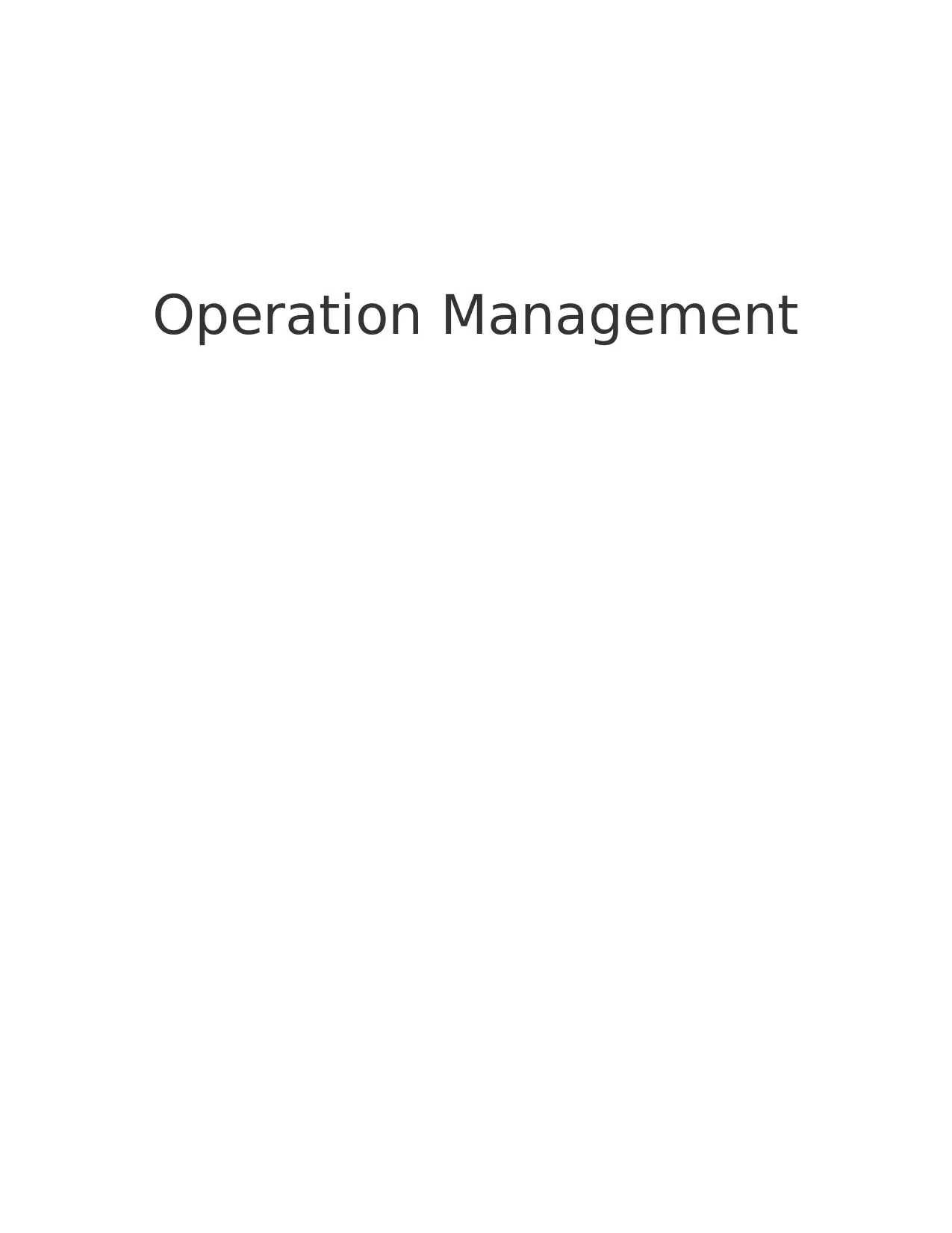
Operation Management
Paraphrase This Document
Need a fresh take? Get an instant paraphrase of this document with our AI Paraphraser
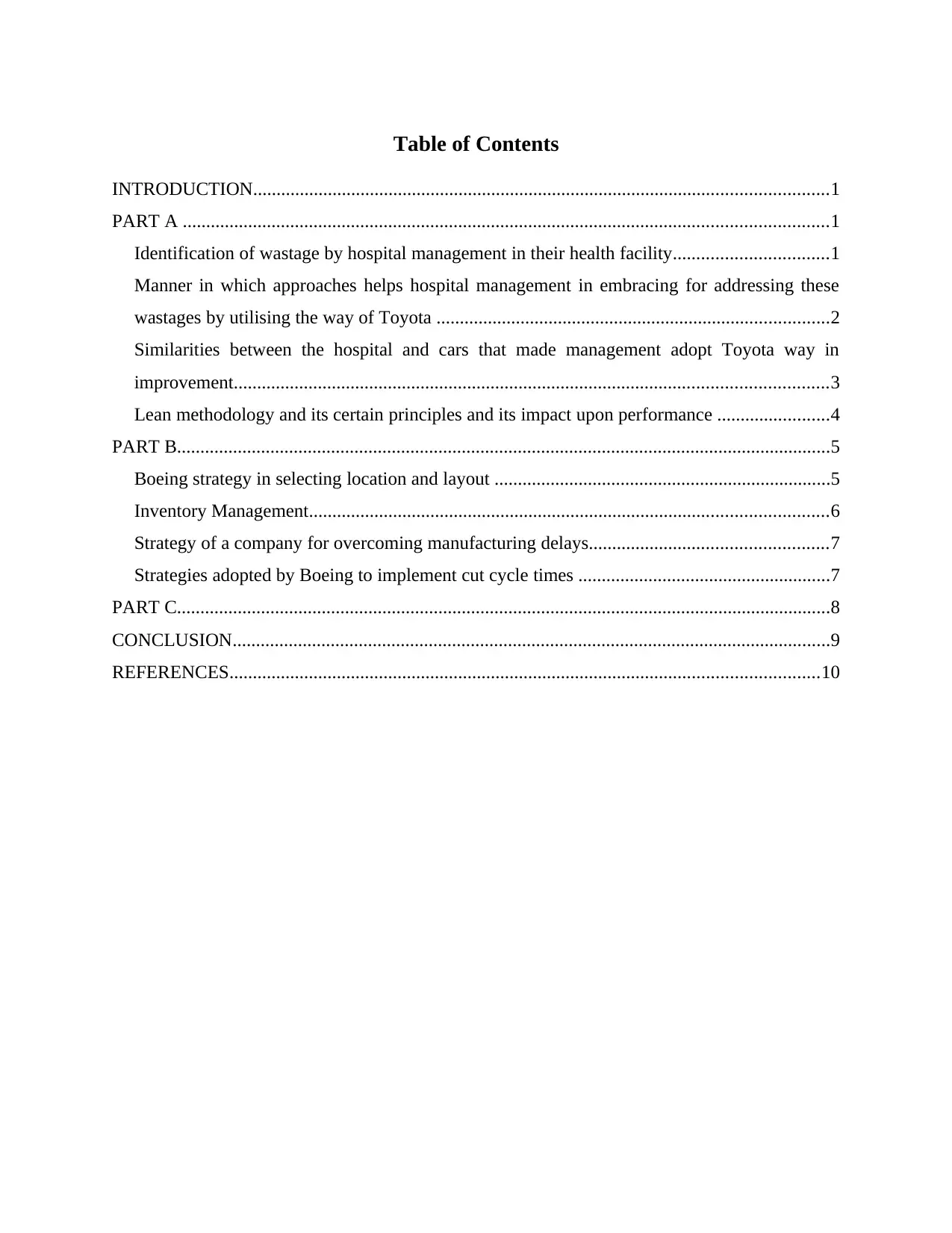
Table of Contents
INTRODUCTION...........................................................................................................................1
PART A ..........................................................................................................................................1
Identification of wastage by hospital management in their health facility.................................1
Manner in which approaches helps hospital management in embracing for addressing these
wastages by utilising the way of Toyota ....................................................................................2
Similarities between the hospital and cars that made management adopt Toyota way in
improvement...............................................................................................................................3
Lean methodology and its certain principles and its impact upon performance ........................4
PART B............................................................................................................................................5
Boeing strategy in selecting location and layout ........................................................................5
Inventory Management...............................................................................................................6
Strategy of a company for overcoming manufacturing delays...................................................7
Strategies adopted by Boeing to implement cut cycle times ......................................................7
PART C............................................................................................................................................8
CONCLUSION................................................................................................................................9
REFERENCES..............................................................................................................................10
INTRODUCTION...........................................................................................................................1
PART A ..........................................................................................................................................1
Identification of wastage by hospital management in their health facility.................................1
Manner in which approaches helps hospital management in embracing for addressing these
wastages by utilising the way of Toyota ....................................................................................2
Similarities between the hospital and cars that made management adopt Toyota way in
improvement...............................................................................................................................3
Lean methodology and its certain principles and its impact upon performance ........................4
PART B............................................................................................................................................5
Boeing strategy in selecting location and layout ........................................................................5
Inventory Management...............................................................................................................6
Strategy of a company for overcoming manufacturing delays...................................................7
Strategies adopted by Boeing to implement cut cycle times ......................................................7
PART C............................................................................................................................................8
CONCLUSION................................................................................................................................9
REFERENCES..............................................................................................................................10
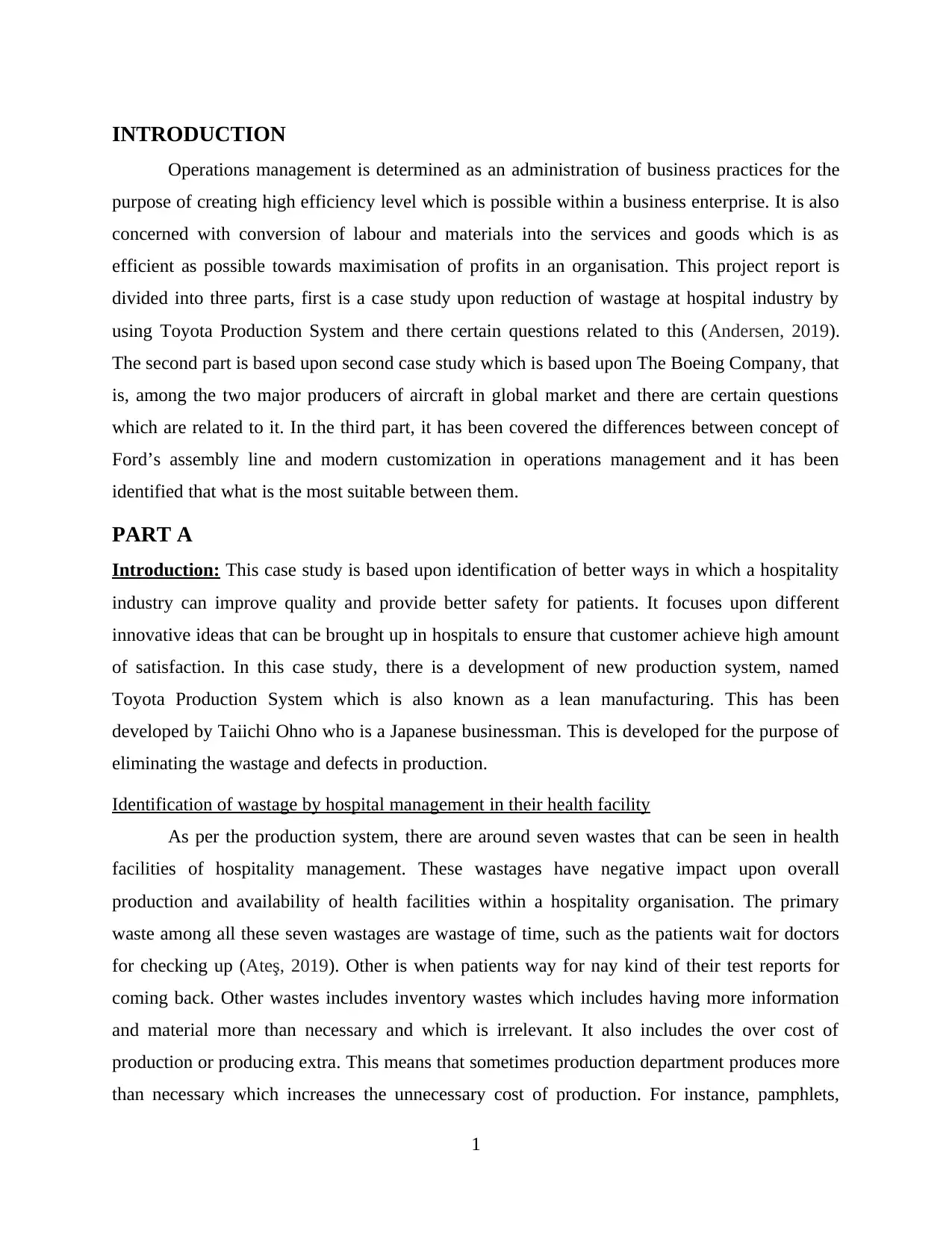
INTRODUCTION
Operations management is determined as an administration of business practices for the
purpose of creating high efficiency level which is possible within a business enterprise. It is also
concerned with conversion of labour and materials into the services and goods which is as
efficient as possible towards maximisation of profits in an organisation. This project report is
divided into three parts, first is a case study upon reduction of wastage at hospital industry by
using Toyota Production System and there certain questions related to this (Andersen, 2019).
The second part is based upon second case study which is based upon The Boeing Company, that
is, among the two major producers of aircraft in global market and there are certain questions
which are related to it. In the third part, it has been covered the differences between concept of
Ford’s assembly line and modern customization in operations management and it has been
identified that what is the most suitable between them.
PART A
Introduction: This case study is based upon identification of better ways in which a hospitality
industry can improve quality and provide better safety for patients. It focuses upon different
innovative ideas that can be brought up in hospitals to ensure that customer achieve high amount
of satisfaction. In this case study, there is a development of new production system, named
Toyota Production System which is also known as a lean manufacturing. This has been
developed by Taiichi Ohno who is a Japanese businessman. This is developed for the purpose of
eliminating the wastage and defects in production.
Identification of wastage by hospital management in their health facility
As per the production system, there are around seven wastes that can be seen in health
facilities of hospitality management. These wastages have negative impact upon overall
production and availability of health facilities within a hospitality organisation. The primary
waste among all these seven wastages are wastage of time, such as the patients wait for doctors
for checking up (Ateş, 2019). Other is when patients way for nay kind of their test reports for
coming back. Other wastes includes inventory wastes which includes having more information
and material more than necessary and which is irrelevant. It also includes the over cost of
production or producing extra. This means that sometimes production department produces more
than necessary which increases the unnecessary cost of production. For instance, pamphlets,
1
Operations management is determined as an administration of business practices for the
purpose of creating high efficiency level which is possible within a business enterprise. It is also
concerned with conversion of labour and materials into the services and goods which is as
efficient as possible towards maximisation of profits in an organisation. This project report is
divided into three parts, first is a case study upon reduction of wastage at hospital industry by
using Toyota Production System and there certain questions related to this (Andersen, 2019).
The second part is based upon second case study which is based upon The Boeing Company, that
is, among the two major producers of aircraft in global market and there are certain questions
which are related to it. In the third part, it has been covered the differences between concept of
Ford’s assembly line and modern customization in operations management and it has been
identified that what is the most suitable between them.
PART A
Introduction: This case study is based upon identification of better ways in which a hospitality
industry can improve quality and provide better safety for patients. It focuses upon different
innovative ideas that can be brought up in hospitals to ensure that customer achieve high amount
of satisfaction. In this case study, there is a development of new production system, named
Toyota Production System which is also known as a lean manufacturing. This has been
developed by Taiichi Ohno who is a Japanese businessman. This is developed for the purpose of
eliminating the wastage and defects in production.
Identification of wastage by hospital management in their health facility
As per the production system, there are around seven wastes that can be seen in health
facilities of hospitality management. These wastages have negative impact upon overall
production and availability of health facilities within a hospitality organisation. The primary
waste among all these seven wastages are wastage of time, such as the patients wait for doctors
for checking up (Ateş, 2019). Other is when patients way for nay kind of their test reports for
coming back. Other wastes includes inventory wastes which includes having more information
and material more than necessary and which is irrelevant. It also includes the over cost of
production or producing extra. This means that sometimes production department produces more
than necessary which increases the unnecessary cost of production. For instance, pamphlets,
1
⊘ This is a preview!⊘
Do you want full access?
Subscribe today to unlock all pages.

Trusted by 1+ million students worldwide
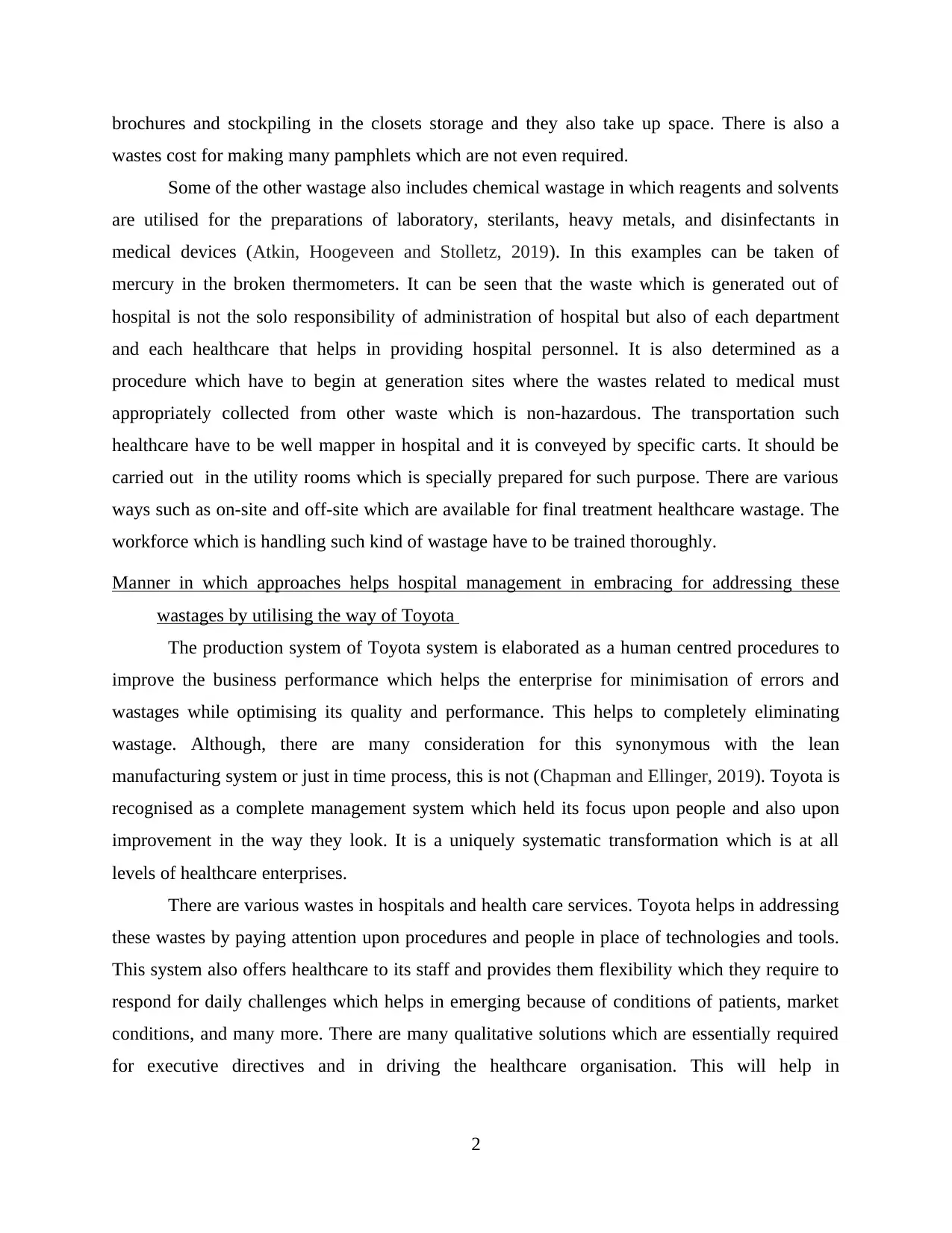
brochures and stockpiling in the closets storage and they also take up space. There is also a
wastes cost for making many pamphlets which are not even required.
Some of the other wastage also includes chemical wastage in which reagents and solvents
are utilised for the preparations of laboratory, sterilants, heavy metals, and disinfectants in
medical devices (Atkin, Hoogeveen and Stolletz, 2019). In this examples can be taken of
mercury in the broken thermometers. It can be seen that the waste which is generated out of
hospital is not the solo responsibility of administration of hospital but also of each department
and each healthcare that helps in providing hospital personnel. It is also determined as a
procedure which have to begin at generation sites where the wastes related to medical must
appropriately collected from other waste which is non-hazardous. The transportation such
healthcare have to be well mapper in hospital and it is conveyed by specific carts. It should be
carried out in the utility rooms which is specially prepared for such purpose. There are various
ways such as on-site and off-site which are available for final treatment healthcare wastage. The
workforce which is handling such kind of wastage have to be trained thoroughly.
Manner in which approaches helps hospital management in embracing for addressing these
wastages by utilising the way of Toyota
The production system of Toyota system is elaborated as a human centred procedures to
improve the business performance which helps the enterprise for minimisation of errors and
wastages while optimising its quality and performance. This helps to completely eliminating
wastage. Although, there are many consideration for this synonymous with the lean
manufacturing system or just in time process, this is not (Chapman and Ellinger, 2019). Toyota is
recognised as a complete management system which held its focus upon people and also upon
improvement in the way they look. It is a uniquely systematic transformation which is at all
levels of healthcare enterprises.
There are various wastes in hospitals and health care services. Toyota helps in addressing
these wastes by paying attention upon procedures and people in place of technologies and tools.
This system also offers healthcare to its staff and provides them flexibility which they require to
respond for daily challenges which helps in emerging because of conditions of patients, market
conditions, and many more. There are many qualitative solutions which are essentially required
for executive directives and in driving the healthcare organisation. This will help in
2
wastes cost for making many pamphlets which are not even required.
Some of the other wastage also includes chemical wastage in which reagents and solvents
are utilised for the preparations of laboratory, sterilants, heavy metals, and disinfectants in
medical devices (Atkin, Hoogeveen and Stolletz, 2019). In this examples can be taken of
mercury in the broken thermometers. It can be seen that the waste which is generated out of
hospital is not the solo responsibility of administration of hospital but also of each department
and each healthcare that helps in providing hospital personnel. It is also determined as a
procedure which have to begin at generation sites where the wastes related to medical must
appropriately collected from other waste which is non-hazardous. The transportation such
healthcare have to be well mapper in hospital and it is conveyed by specific carts. It should be
carried out in the utility rooms which is specially prepared for such purpose. There are various
ways such as on-site and off-site which are available for final treatment healthcare wastage. The
workforce which is handling such kind of wastage have to be trained thoroughly.
Manner in which approaches helps hospital management in embracing for addressing these
wastages by utilising the way of Toyota
The production system of Toyota system is elaborated as a human centred procedures to
improve the business performance which helps the enterprise for minimisation of errors and
wastages while optimising its quality and performance. This helps to completely eliminating
wastage. Although, there are many consideration for this synonymous with the lean
manufacturing system or just in time process, this is not (Chapman and Ellinger, 2019). Toyota is
recognised as a complete management system which held its focus upon people and also upon
improvement in the way they look. It is a uniquely systematic transformation which is at all
levels of healthcare enterprises.
There are various wastes in hospitals and health care services. Toyota helps in addressing
these wastes by paying attention upon procedures and people in place of technologies and tools.
This system also offers healthcare to its staff and provides them flexibility which they require to
respond for daily challenges which helps in emerging because of conditions of patients, market
conditions, and many more. There are many qualitative solutions which are essentially required
for executive directives and in driving the healthcare organisation. This will help in
2
Paraphrase This Document
Need a fresh take? Get an instant paraphrase of this document with our AI Paraphraser
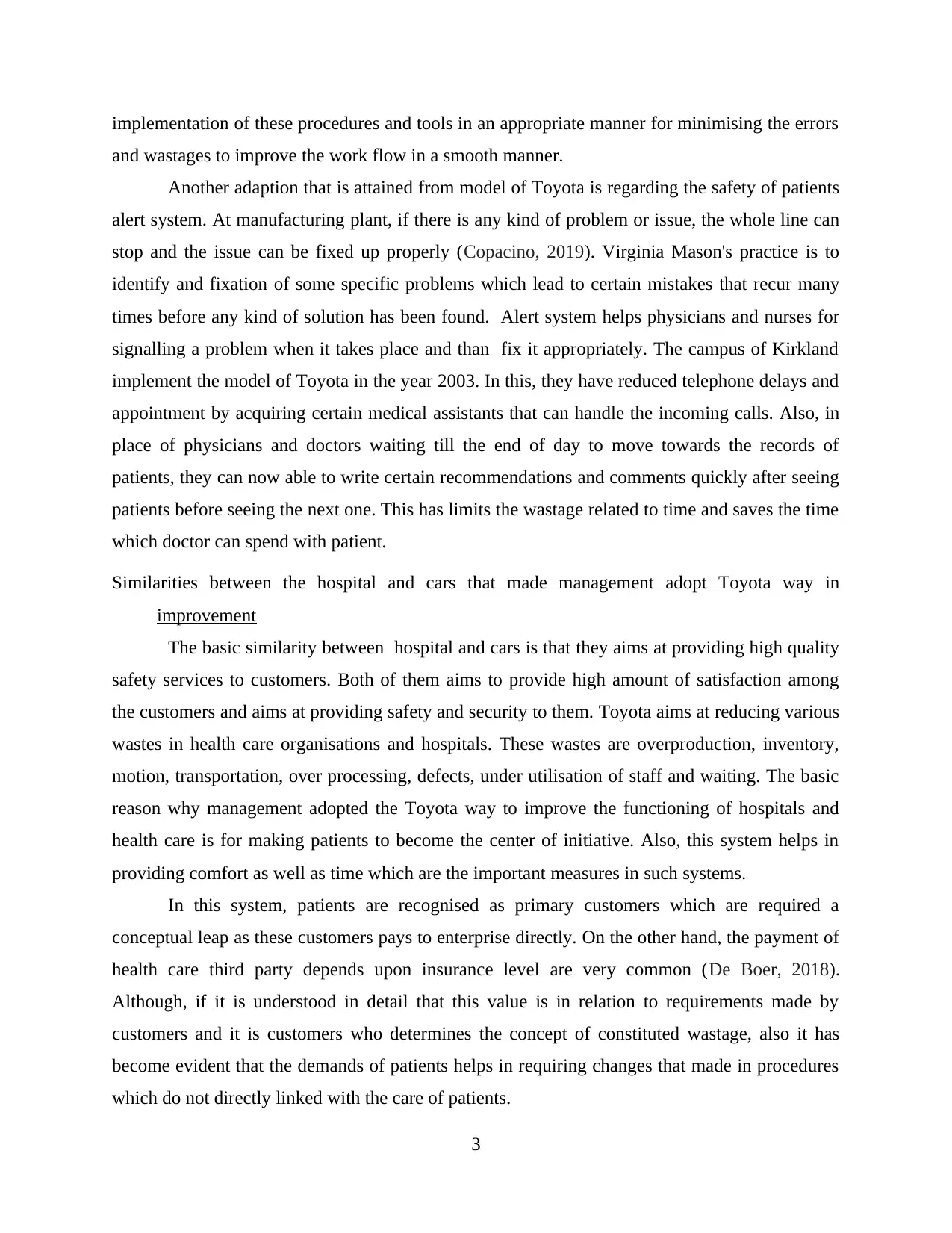
implementation of these procedures and tools in an appropriate manner for minimising the errors
and wastages to improve the work flow in a smooth manner.
Another adaption that is attained from model of Toyota is regarding the safety of patients
alert system. At manufacturing plant, if there is any kind of problem or issue, the whole line can
stop and the issue can be fixed up properly (Copacino, 2019). Virginia Mason's practice is to
identify and fixation of some specific problems which lead to certain mistakes that recur many
times before any kind of solution has been found. Alert system helps physicians and nurses for
signalling a problem when it takes place and than fix it appropriately. The campus of Kirkland
implement the model of Toyota in the year 2003. In this, they have reduced telephone delays and
appointment by acquiring certain medical assistants that can handle the incoming calls. Also, in
place of physicians and doctors waiting till the end of day to move towards the records of
patients, they can now able to write certain recommendations and comments quickly after seeing
patients before seeing the next one. This has limits the wastage related to time and saves the time
which doctor can spend with patient.
Similarities between the hospital and cars that made management adopt Toyota way in
improvement
The basic similarity between hospital and cars is that they aims at providing high quality
safety services to customers. Both of them aims to provide high amount of satisfaction among
the customers and aims at providing safety and security to them. Toyota aims at reducing various
wastes in health care organisations and hospitals. These wastes are overproduction, inventory,
motion, transportation, over processing, defects, under utilisation of staff and waiting. The basic
reason why management adopted the Toyota way to improve the functioning of hospitals and
health care is for making patients to become the center of initiative. Also, this system helps in
providing comfort as well as time which are the important measures in such systems.
In this system, patients are recognised as primary customers which are required a
conceptual leap as these customers pays to enterprise directly. On the other hand, the payment of
health care third party depends upon insurance level are very common (De Boer, 2018).
Although, if it is understood in detail that this value is in relation to requirements made by
customers and it is customers who determines the concept of constituted wastage, also it has
become evident that the demands of patients helps in requiring changes that made in procedures
which do not directly linked with the care of patients.
3
and wastages to improve the work flow in a smooth manner.
Another adaption that is attained from model of Toyota is regarding the safety of patients
alert system. At manufacturing plant, if there is any kind of problem or issue, the whole line can
stop and the issue can be fixed up properly (Copacino, 2019). Virginia Mason's practice is to
identify and fixation of some specific problems which lead to certain mistakes that recur many
times before any kind of solution has been found. Alert system helps physicians and nurses for
signalling a problem when it takes place and than fix it appropriately. The campus of Kirkland
implement the model of Toyota in the year 2003. In this, they have reduced telephone delays and
appointment by acquiring certain medical assistants that can handle the incoming calls. Also, in
place of physicians and doctors waiting till the end of day to move towards the records of
patients, they can now able to write certain recommendations and comments quickly after seeing
patients before seeing the next one. This has limits the wastage related to time and saves the time
which doctor can spend with patient.
Similarities between the hospital and cars that made management adopt Toyota way in
improvement
The basic similarity between hospital and cars is that they aims at providing high quality
safety services to customers. Both of them aims to provide high amount of satisfaction among
the customers and aims at providing safety and security to them. Toyota aims at reducing various
wastes in health care organisations and hospitals. These wastes are overproduction, inventory,
motion, transportation, over processing, defects, under utilisation of staff and waiting. The basic
reason why management adopted the Toyota way to improve the functioning of hospitals and
health care is for making patients to become the center of initiative. Also, this system helps in
providing comfort as well as time which are the important measures in such systems.
In this system, patients are recognised as primary customers which are required a
conceptual leap as these customers pays to enterprise directly. On the other hand, the payment of
health care third party depends upon insurance level are very common (De Boer, 2018).
Although, if it is understood in detail that this value is in relation to requirements made by
customers and it is customers who determines the concept of constituted wastage, also it has
become evident that the demands of patients helps in requiring changes that made in procedures
which do not directly linked with the care of patients.
3
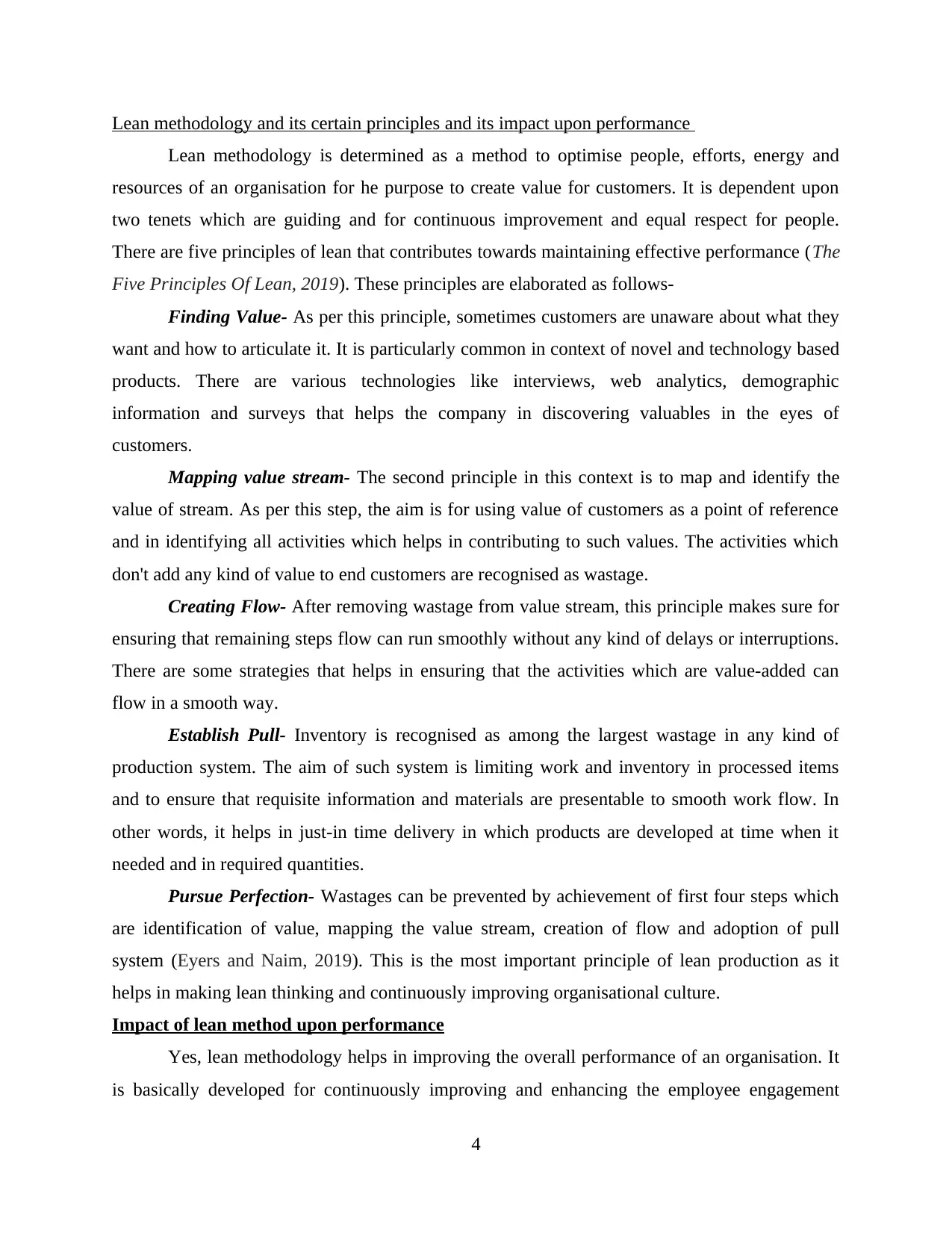
Lean methodology and its certain principles and its impact upon performance
Lean methodology is determined as a method to optimise people, efforts, energy and
resources of an organisation for he purpose to create value for customers. It is dependent upon
two tenets which are guiding and for continuous improvement and equal respect for people.
There are five principles of lean that contributes towards maintaining effective performance (The
Five Principles Of Lean, 2019). These principles are elaborated as follows-
Finding Value- As per this principle, sometimes customers are unaware about what they
want and how to articulate it. It is particularly common in context of novel and technology based
products. There are various technologies like interviews, web analytics, demographic
information and surveys that helps the company in discovering valuables in the eyes of
customers.
Mapping value stream- The second principle in this context is to map and identify the
value of stream. As per this step, the aim is for using value of customers as a point of reference
and in identifying all activities which helps in contributing to such values. The activities which
don't add any kind of value to end customers are recognised as wastage.
Creating Flow- After removing wastage from value stream, this principle makes sure for
ensuring that remaining steps flow can run smoothly without any kind of delays or interruptions.
There are some strategies that helps in ensuring that the activities which are value-added can
flow in a smooth way.
Establish Pull- Inventory is recognised as among the largest wastage in any kind of
production system. The aim of such system is limiting work and inventory in processed items
and to ensure that requisite information and materials are presentable to smooth work flow. In
other words, it helps in just-in time delivery in which products are developed at time when it
needed and in required quantities.
Pursue Perfection- Wastages can be prevented by achievement of first four steps which
are identification of value, mapping the value stream, creation of flow and adoption of pull
system (Eyers and Naim, 2019). This is the most important principle of lean production as it
helps in making lean thinking and continuously improving organisational culture.
Impact of lean method upon performance
Yes, lean methodology helps in improving the overall performance of an organisation. It
is basically developed for continuously improving and enhancing the employee engagement
4
Lean methodology is determined as a method to optimise people, efforts, energy and
resources of an organisation for he purpose to create value for customers. It is dependent upon
two tenets which are guiding and for continuous improvement and equal respect for people.
There are five principles of lean that contributes towards maintaining effective performance (The
Five Principles Of Lean, 2019). These principles are elaborated as follows-
Finding Value- As per this principle, sometimes customers are unaware about what they
want and how to articulate it. It is particularly common in context of novel and technology based
products. There are various technologies like interviews, web analytics, demographic
information and surveys that helps the company in discovering valuables in the eyes of
customers.
Mapping value stream- The second principle in this context is to map and identify the
value of stream. As per this step, the aim is for using value of customers as a point of reference
and in identifying all activities which helps in contributing to such values. The activities which
don't add any kind of value to end customers are recognised as wastage.
Creating Flow- After removing wastage from value stream, this principle makes sure for
ensuring that remaining steps flow can run smoothly without any kind of delays or interruptions.
There are some strategies that helps in ensuring that the activities which are value-added can
flow in a smooth way.
Establish Pull- Inventory is recognised as among the largest wastage in any kind of
production system. The aim of such system is limiting work and inventory in processed items
and to ensure that requisite information and materials are presentable to smooth work flow. In
other words, it helps in just-in time delivery in which products are developed at time when it
needed and in required quantities.
Pursue Perfection- Wastages can be prevented by achievement of first four steps which
are identification of value, mapping the value stream, creation of flow and adoption of pull
system (Eyers and Naim, 2019). This is the most important principle of lean production as it
helps in making lean thinking and continuously improving organisational culture.
Impact of lean method upon performance
Yes, lean methodology helps in improving the overall performance of an organisation. It
is basically developed for continuously improving and enhancing the employee engagement
4
⊘ This is a preview!⊘
Do you want full access?
Subscribe today to unlock all pages.

Trusted by 1+ million students worldwide
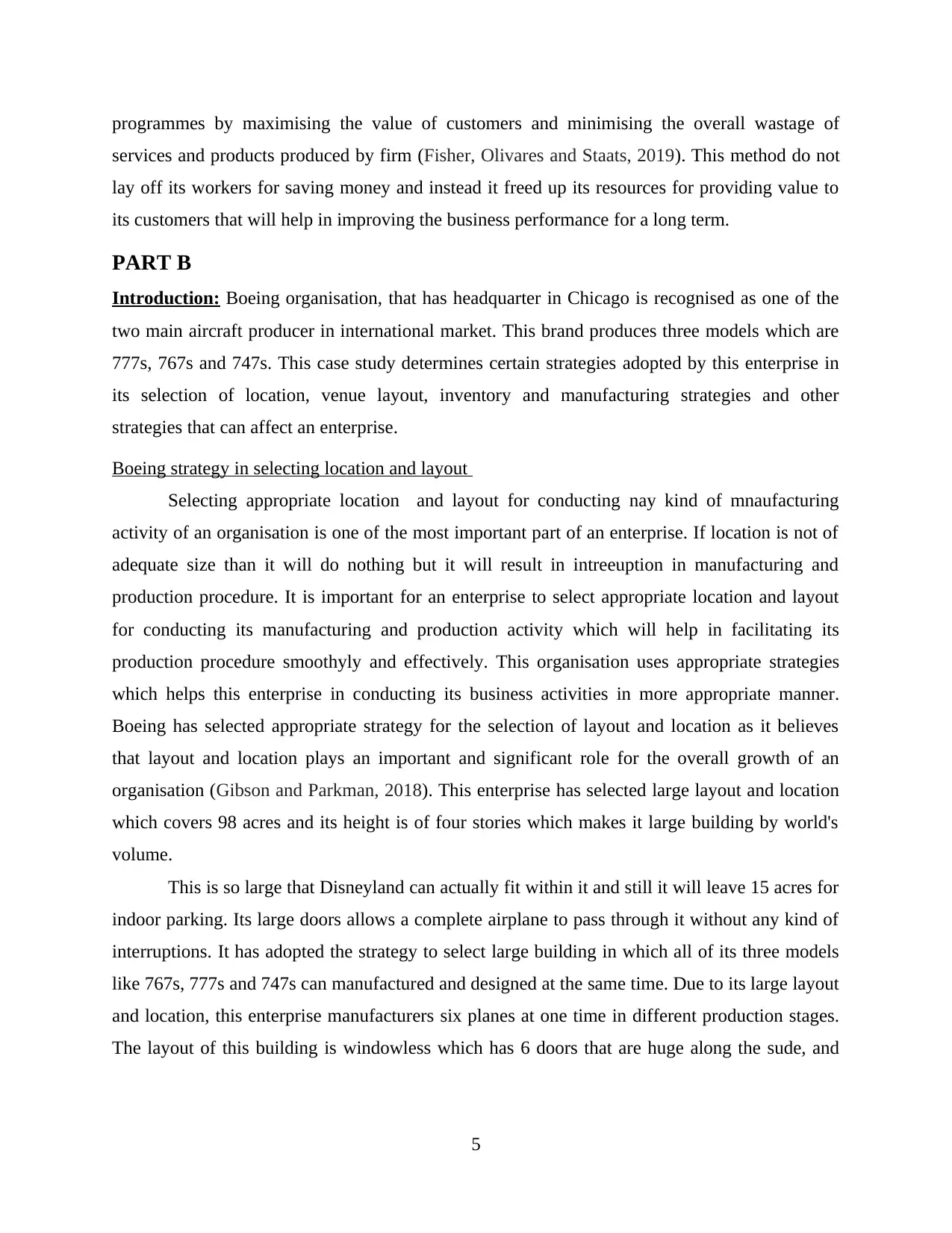
programmes by maximising the value of customers and minimising the overall wastage of
services and products produced by firm (Fisher, Olivares and Staats, 2019). This method do not
lay off its workers for saving money and instead it freed up its resources for providing value to
its customers that will help in improving the business performance for a long term.
PART B
Introduction: Boeing organisation, that has headquarter in Chicago is recognised as one of the
two main aircraft producer in international market. This brand produces three models which are
777s, 767s and 747s. This case study determines certain strategies adopted by this enterprise in
its selection of location, venue layout, inventory and manufacturing strategies and other
strategies that can affect an enterprise.
Boeing strategy in selecting location and layout
Selecting appropriate location and layout for conducting nay kind of mnaufacturing
activity of an organisation is one of the most important part of an enterprise. If location is not of
adequate size than it will do nothing but it will result in intreeuption in manufacturing and
production procedure. It is important for an enterprise to select appropriate location and layout
for conducting its manufacturing and production activity which will help in facilitating its
production procedure smoothyly and effectively. This organisation uses appropriate strategies
which helps this enterprise in conducting its business activities in more appropriate manner.
Boeing has selected appropriate strategy for the selection of layout and location as it believes
that layout and location plays an important and significant role for the overall growth of an
organisation (Gibson and Parkman, 2018). This enterprise has selected large layout and location
which covers 98 acres and its height is of four stories which makes it large building by world's
volume.
This is so large that Disneyland can actually fit within it and still it will leave 15 acres for
indoor parking. Its large doors allows a complete airplane to pass through it without any kind of
interruptions. It has adopted the strategy to select large building in which all of its three models
like 767s, 777s and 747s can manufactured and designed at the same time. Due to its large layout
and location, this enterprise manufacturers six planes at one time in different production stages.
The layout of this building is windowless which has 6 doors that are huge along the sude, and
5
services and products produced by firm (Fisher, Olivares and Staats, 2019). This method do not
lay off its workers for saving money and instead it freed up its resources for providing value to
its customers that will help in improving the business performance for a long term.
PART B
Introduction: Boeing organisation, that has headquarter in Chicago is recognised as one of the
two main aircraft producer in international market. This brand produces three models which are
777s, 767s and 747s. This case study determines certain strategies adopted by this enterprise in
its selection of location, venue layout, inventory and manufacturing strategies and other
strategies that can affect an enterprise.
Boeing strategy in selecting location and layout
Selecting appropriate location and layout for conducting nay kind of mnaufacturing
activity of an organisation is one of the most important part of an enterprise. If location is not of
adequate size than it will do nothing but it will result in intreeuption in manufacturing and
production procedure. It is important for an enterprise to select appropriate location and layout
for conducting its manufacturing and production activity which will help in facilitating its
production procedure smoothyly and effectively. This organisation uses appropriate strategies
which helps this enterprise in conducting its business activities in more appropriate manner.
Boeing has selected appropriate strategy for the selection of layout and location as it believes
that layout and location plays an important and significant role for the overall growth of an
organisation (Gibson and Parkman, 2018). This enterprise has selected large layout and location
which covers 98 acres and its height is of four stories which makes it large building by world's
volume.
This is so large that Disneyland can actually fit within it and still it will leave 15 acres for
indoor parking. Its large doors allows a complete airplane to pass through it without any kind of
interruptions. It has adopted the strategy to select large building in which all of its three models
like 767s, 777s and 747s can manufactured and designed at the same time. Due to its large layout
and location, this enterprise manufacturers six planes at one time in different production stages.
The layout of this building is windowless which has 6 doors that are huge along the sude, and
5
Paraphrase This Document
Need a fresh take? Get an instant paraphrase of this document with our AI Paraphraser
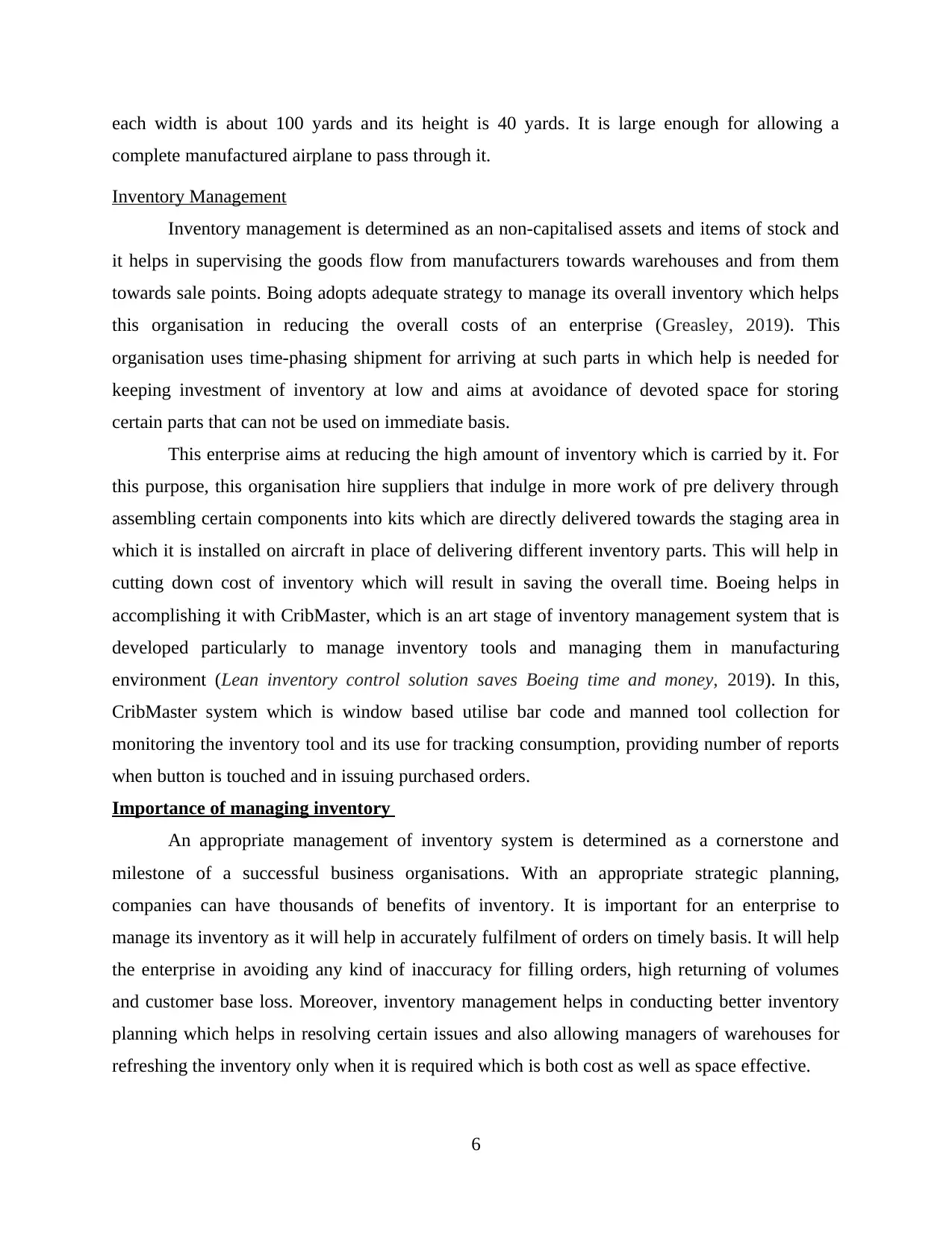
each width is about 100 yards and its height is 40 yards. It is large enough for allowing a
complete manufactured airplane to pass through it.
Inventory Management
Inventory management is determined as an non-capitalised assets and items of stock and
it helps in supervising the goods flow from manufacturers towards warehouses and from them
towards sale points. Boing adopts adequate strategy to manage its overall inventory which helps
this organisation in reducing the overall costs of an enterprise (Greasley, 2019). This
organisation uses time-phasing shipment for arriving at such parts in which help is needed for
keeping investment of inventory at low and aims at avoidance of devoted space for storing
certain parts that can not be used on immediate basis.
This enterprise aims at reducing the high amount of inventory which is carried by it. For
this purpose, this organisation hire suppliers that indulge in more work of pre delivery through
assembling certain components into kits which are directly delivered towards the staging area in
which it is installed on aircraft in place of delivering different inventory parts. This will help in
cutting down cost of inventory which will result in saving the overall time. Boeing helps in
accomplishing it with CribMaster, which is an art stage of inventory management system that is
developed particularly to manage inventory tools and managing them in manufacturing
environment (Lean inventory control solution saves Boeing time and money, 2019). In this,
CribMaster system which is window based utilise bar code and manned tool collection for
monitoring the inventory tool and its use for tracking consumption, providing number of reports
when button is touched and in issuing purchased orders.
Importance of managing inventory
An appropriate management of inventory system is determined as a cornerstone and
milestone of a successful business organisations. With an appropriate strategic planning,
companies can have thousands of benefits of inventory. It is important for an enterprise to
manage its inventory as it will help in accurately fulfilment of orders on timely basis. It will help
the enterprise in avoiding any kind of inaccuracy for filling orders, high returning of volumes
and customer base loss. Moreover, inventory management helps in conducting better inventory
planning which helps in resolving certain issues and also allowing managers of warehouses for
refreshing the inventory only when it is required which is both cost as well as space effective.
6
complete manufactured airplane to pass through it.
Inventory Management
Inventory management is determined as an non-capitalised assets and items of stock and
it helps in supervising the goods flow from manufacturers towards warehouses and from them
towards sale points. Boing adopts adequate strategy to manage its overall inventory which helps
this organisation in reducing the overall costs of an enterprise (Greasley, 2019). This
organisation uses time-phasing shipment for arriving at such parts in which help is needed for
keeping investment of inventory at low and aims at avoidance of devoted space for storing
certain parts that can not be used on immediate basis.
This enterprise aims at reducing the high amount of inventory which is carried by it. For
this purpose, this organisation hire suppliers that indulge in more work of pre delivery through
assembling certain components into kits which are directly delivered towards the staging area in
which it is installed on aircraft in place of delivering different inventory parts. This will help in
cutting down cost of inventory which will result in saving the overall time. Boeing helps in
accomplishing it with CribMaster, which is an art stage of inventory management system that is
developed particularly to manage inventory tools and managing them in manufacturing
environment (Lean inventory control solution saves Boeing time and money, 2019). In this,
CribMaster system which is window based utilise bar code and manned tool collection for
monitoring the inventory tool and its use for tracking consumption, providing number of reports
when button is touched and in issuing purchased orders.
Importance of managing inventory
An appropriate management of inventory system is determined as a cornerstone and
milestone of a successful business organisations. With an appropriate strategic planning,
companies can have thousands of benefits of inventory. It is important for an enterprise to
manage its inventory as it will help in accurately fulfilment of orders on timely basis. It will help
the enterprise in avoiding any kind of inaccuracy for filling orders, high returning of volumes
and customer base loss. Moreover, inventory management helps in conducting better inventory
planning which helps in resolving certain issues and also allowing managers of warehouses for
refreshing the inventory only when it is required which is both cost as well as space effective.
6
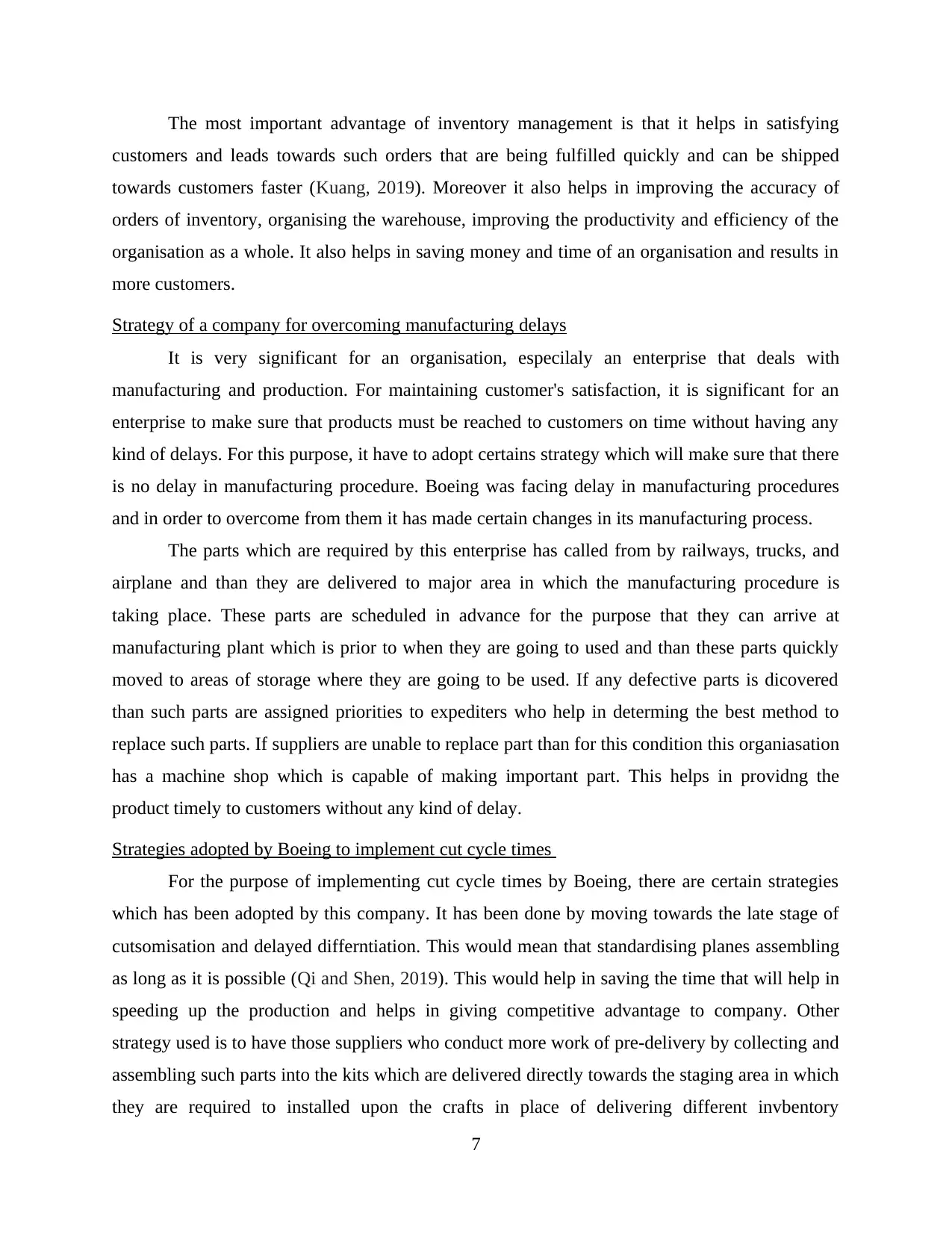
The most important advantage of inventory management is that it helps in satisfying
customers and leads towards such orders that are being fulfilled quickly and can be shipped
towards customers faster (Kuang, 2019). Moreover it also helps in improving the accuracy of
orders of inventory, organising the warehouse, improving the productivity and efficiency of the
organisation as a whole. It also helps in saving money and time of an organisation and results in
more customers.
Strategy of a company for overcoming manufacturing delays
It is very significant for an organisation, especilaly an enterprise that deals with
manufacturing and production. For maintaining customer's satisfaction, it is significant for an
enterprise to make sure that products must be reached to customers on time without having any
kind of delays. For this purpose, it have to adopt certains strategy which will make sure that there
is no delay in manufacturing procedure. Boeing was facing delay in manufacturing procedures
and in order to overcome from them it has made certain changes in its manufacturing process.
The parts which are required by this enterprise has called from by railways, trucks, and
airplane and than they are delivered to major area in which the manufacturing procedure is
taking place. These parts are scheduled in advance for the purpose that they can arrive at
manufacturing plant which is prior to when they are going to used and than these parts quickly
moved to areas of storage where they are going to be used. If any defective parts is dicovered
than such parts are assigned priorities to expediters who help in determing the best method to
replace such parts. If suppliers are unable to replace part than for this condition this organiasation
has a machine shop which is capable of making important part. This helps in providng the
product timely to customers without any kind of delay.
Strategies adopted by Boeing to implement cut cycle times
For the purpose of implementing cut cycle times by Boeing, there are certain strategies
which has been adopted by this company. It has been done by moving towards the late stage of
cutsomisation and delayed differntiation. This would mean that standardising planes assembling
as long as it is possible (Qi and Shen, 2019). This would help in saving the time that will help in
speeding up the production and helps in giving competitive advantage to company. Other
strategy used is to have those suppliers who conduct more work of pre-delivery by collecting and
assembling such parts into the kits which are delivered directly towards the staging area in which
they are required to installed upon the crafts in place of delivering different invbentory
7
customers and leads towards such orders that are being fulfilled quickly and can be shipped
towards customers faster (Kuang, 2019). Moreover it also helps in improving the accuracy of
orders of inventory, organising the warehouse, improving the productivity and efficiency of the
organisation as a whole. It also helps in saving money and time of an organisation and results in
more customers.
Strategy of a company for overcoming manufacturing delays
It is very significant for an organisation, especilaly an enterprise that deals with
manufacturing and production. For maintaining customer's satisfaction, it is significant for an
enterprise to make sure that products must be reached to customers on time without having any
kind of delays. For this purpose, it have to adopt certains strategy which will make sure that there
is no delay in manufacturing procedure. Boeing was facing delay in manufacturing procedures
and in order to overcome from them it has made certain changes in its manufacturing process.
The parts which are required by this enterprise has called from by railways, trucks, and
airplane and than they are delivered to major area in which the manufacturing procedure is
taking place. These parts are scheduled in advance for the purpose that they can arrive at
manufacturing plant which is prior to when they are going to used and than these parts quickly
moved to areas of storage where they are going to be used. If any defective parts is dicovered
than such parts are assigned priorities to expediters who help in determing the best method to
replace such parts. If suppliers are unable to replace part than for this condition this organiasation
has a machine shop which is capable of making important part. This helps in providng the
product timely to customers without any kind of delay.
Strategies adopted by Boeing to implement cut cycle times
For the purpose of implementing cut cycle times by Boeing, there are certain strategies
which has been adopted by this company. It has been done by moving towards the late stage of
cutsomisation and delayed differntiation. This would mean that standardising planes assembling
as long as it is possible (Qi and Shen, 2019). This would help in saving the time that will help in
speeding up the production and helps in giving competitive advantage to company. Other
strategy used is to have those suppliers who conduct more work of pre-delivery by collecting and
assembling such parts into the kits which are delivered directly towards the staging area in which
they are required to installed upon the crafts in place of delivering different invbentory
7
⊘ This is a preview!⊘
Do you want full access?
Subscribe today to unlock all pages.

Trusted by 1+ million students worldwide
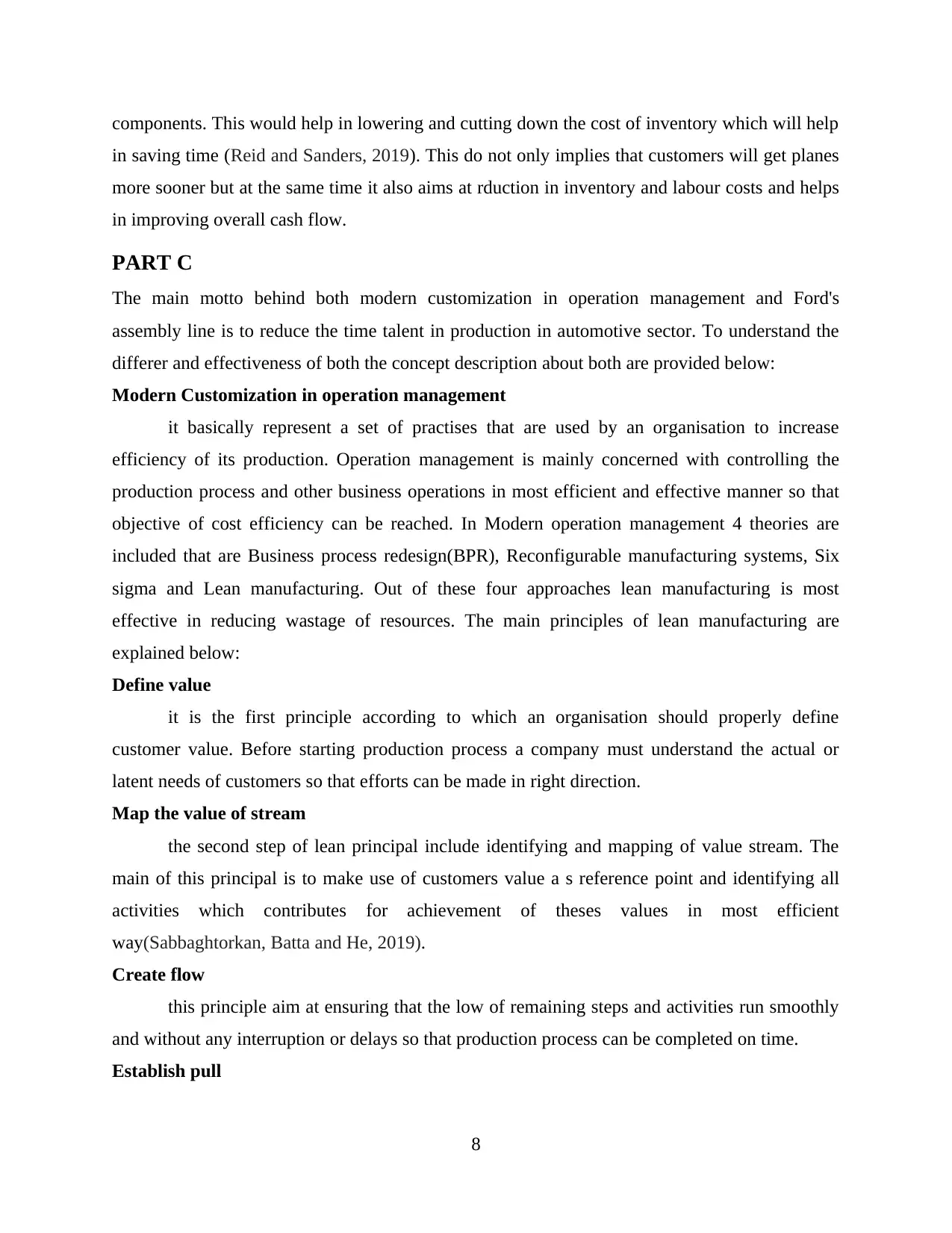
components. This would help in lowering and cutting down the cost of inventory which will help
in saving time (Reid and Sanders, 2019). This do not only implies that customers will get planes
more sooner but at the same time it also aims at rduction in inventory and labour costs and helps
in improving overall cash flow.
PART C
The main motto behind both modern customization in operation management and Ford's
assembly line is to reduce the time talent in production in automotive sector. To understand the
differer and effectiveness of both the concept description about both are provided below:
Modern Customization in operation management
it basically represent a set of practises that are used by an organisation to increase
efficiency of its production. Operation management is mainly concerned with controlling the
production process and other business operations in most efficient and effective manner so that
objective of cost efficiency can be reached. In Modern operation management 4 theories are
included that are Business process redesign(BPR), Reconfigurable manufacturing systems, Six
sigma and Lean manufacturing. Out of these four approaches lean manufacturing is most
effective in reducing wastage of resources. The main principles of lean manufacturing are
explained below:
Define value
it is the first principle according to which an organisation should properly define
customer value. Before starting production process a company must understand the actual or
latent needs of customers so that efforts can be made in right direction.
Map the value of stream
the second step of lean principal include identifying and mapping of value stream. The
main of this principal is to make use of customers value a s reference point and identifying all
activities which contributes for achievement of theses values in most efficient
way(Sabbaghtorkan, Batta and He, 2019).
Create flow
this principle aim at ensuring that the low of remaining steps and activities run smoothly
and without any interruption or delays so that production process can be completed on time.
Establish pull
8
in saving time (Reid and Sanders, 2019). This do not only implies that customers will get planes
more sooner but at the same time it also aims at rduction in inventory and labour costs and helps
in improving overall cash flow.
PART C
The main motto behind both modern customization in operation management and Ford's
assembly line is to reduce the time talent in production in automotive sector. To understand the
differer and effectiveness of both the concept description about both are provided below:
Modern Customization in operation management
it basically represent a set of practises that are used by an organisation to increase
efficiency of its production. Operation management is mainly concerned with controlling the
production process and other business operations in most efficient and effective manner so that
objective of cost efficiency can be reached. In Modern operation management 4 theories are
included that are Business process redesign(BPR), Reconfigurable manufacturing systems, Six
sigma and Lean manufacturing. Out of these four approaches lean manufacturing is most
effective in reducing wastage of resources. The main principles of lean manufacturing are
explained below:
Define value
it is the first principle according to which an organisation should properly define
customer value. Before starting production process a company must understand the actual or
latent needs of customers so that efforts can be made in right direction.
Map the value of stream
the second step of lean principal include identifying and mapping of value stream. The
main of this principal is to make use of customers value a s reference point and identifying all
activities which contributes for achievement of theses values in most efficient
way(Sabbaghtorkan, Batta and He, 2019).
Create flow
this principle aim at ensuring that the low of remaining steps and activities run smoothly
and without any interruption or delays so that production process can be completed on time.
Establish pull
8
Paraphrase This Document
Need a fresh take? Get an instant paraphrase of this document with our AI Paraphraser
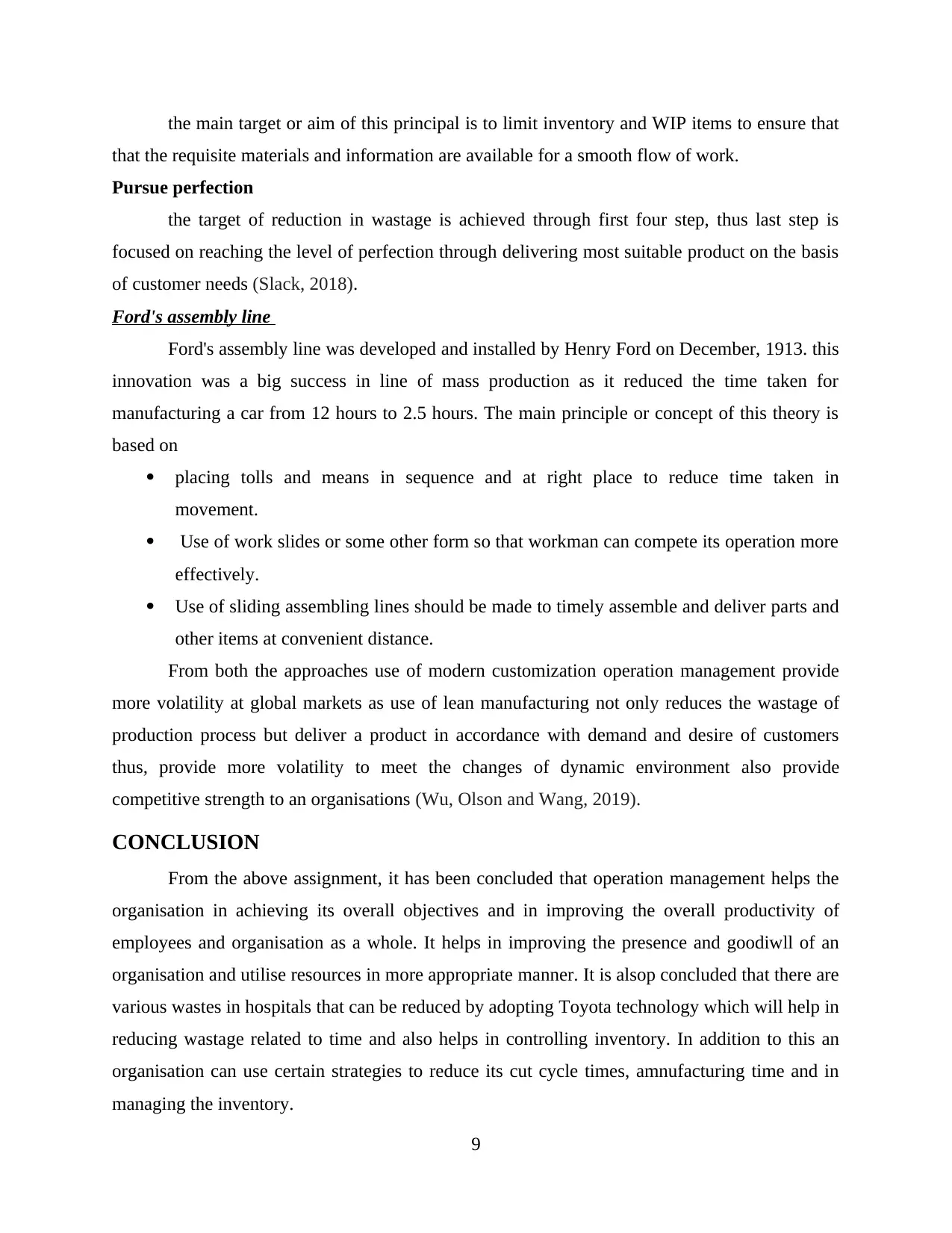
the main target or aim of this principal is to limit inventory and WIP items to ensure that
that the requisite materials and information are available for a smooth flow of work.
Pursue perfection
the target of reduction in wastage is achieved through first four step, thus last step is
focused on reaching the level of perfection through delivering most suitable product on the basis
of customer needs (Slack, 2018).
Ford's assembly line
Ford's assembly line was developed and installed by Henry Ford on December, 1913. this
innovation was a big success in line of mass production as it reduced the time taken for
manufacturing a car from 12 hours to 2.5 hours. The main principle or concept of this theory is
based on
placing tolls and means in sequence and at right place to reduce time taken in
movement.
Use of work slides or some other form so that workman can compete its operation more
effectively.
Use of sliding assembling lines should be made to timely assemble and deliver parts and
other items at convenient distance.
From both the approaches use of modern customization operation management provide
more volatility at global markets as use of lean manufacturing not only reduces the wastage of
production process but deliver a product in accordance with demand and desire of customers
thus, provide more volatility to meet the changes of dynamic environment also provide
competitive strength to an organisations (Wu, Olson and Wang, 2019).
CONCLUSION
From the above assignment, it has been concluded that operation management helps the
organisation in achieving its overall objectives and in improving the overall productivity of
employees and organisation as a whole. It helps in improving the presence and goodiwll of an
organisation and utilise resources in more appropriate manner. It is alsop concluded that there are
various wastes in hospitals that can be reduced by adopting Toyota technology which will help in
reducing wastage related to time and also helps in controlling inventory. In addition to this an
organisation can use certain strategies to reduce its cut cycle times, amnufacturing time and in
managing the inventory.
9
that the requisite materials and information are available for a smooth flow of work.
Pursue perfection
the target of reduction in wastage is achieved through first four step, thus last step is
focused on reaching the level of perfection through delivering most suitable product on the basis
of customer needs (Slack, 2018).
Ford's assembly line
Ford's assembly line was developed and installed by Henry Ford on December, 1913. this
innovation was a big success in line of mass production as it reduced the time taken for
manufacturing a car from 12 hours to 2.5 hours. The main principle or concept of this theory is
based on
placing tolls and means in sequence and at right place to reduce time taken in
movement.
Use of work slides or some other form so that workman can compete its operation more
effectively.
Use of sliding assembling lines should be made to timely assemble and deliver parts and
other items at convenient distance.
From both the approaches use of modern customization operation management provide
more volatility at global markets as use of lean manufacturing not only reduces the wastage of
production process but deliver a product in accordance with demand and desire of customers
thus, provide more volatility to meet the changes of dynamic environment also provide
competitive strength to an organisations (Wu, Olson and Wang, 2019).
CONCLUSION
From the above assignment, it has been concluded that operation management helps the
organisation in achieving its overall objectives and in improving the overall productivity of
employees and organisation as a whole. It helps in improving the presence and goodiwll of an
organisation and utilise resources in more appropriate manner. It is alsop concluded that there are
various wastes in hospitals that can be reduced by adopting Toyota technology which will help in
reducing wastage related to time and also helps in controlling inventory. In addition to this an
organisation can use certain strategies to reduce its cut cycle times, amnufacturing time and in
managing the inventory.
9

REFERENCES
Books and Journals
10
Books and Journals
10
⊘ This is a preview!⊘
Do you want full access?
Subscribe today to unlock all pages.

Trusted by 1+ million students worldwide
1 out of 14
Related Documents
Your All-in-One AI-Powered Toolkit for Academic Success.
+13062052269
info@desklib.com
Available 24*7 on WhatsApp / Email
![[object Object]](/_next/static/media/star-bottom.7253800d.svg)
Unlock your academic potential
Copyright © 2020–2025 A2Z Services. All Rights Reserved. Developed and managed by ZUCOL.




